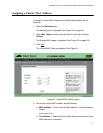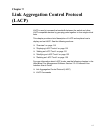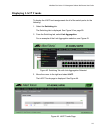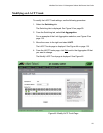
Chapter 9: Link Aggregation Control Protocol (LACP)
118
Overview
LACP trunks are similar in function to static port trunks, but they are more
flexible. The implementations of static trunks tend to be vendor specific
and may not always be compatible. In contrast, the implementation of
LACP in the switch is compliant with the IEEE 802.3ad standard. It is
interoperable with equipment from other vendors that also comply with the
standard. This makes it possible to create LACP trunks between the
switch and network devices from other manufacturers.
The main component of an LACP trunk is an aggregator. An aggregator is
a group of ports on the switch. The ports of an aggregator are further
grouped into a trunk, referred to as an aggregate trunk. An aggregator
can have only one trunk. You have to create a separate aggregator for
each trunk on the switch.
An aggregate trunk can consist of any number of ports on the switch, but
only a maximum of eight ports can be active at a time. If an aggregate
trunk contains more ports than can be active at one time, the extra ports
are placed in standby mode. Ports in standby mode do not pass network
traffic, but they do transmit and accept LACP data unit (LACPDU) packets,
which the switch uses to search for LACP-compliant devices.


















